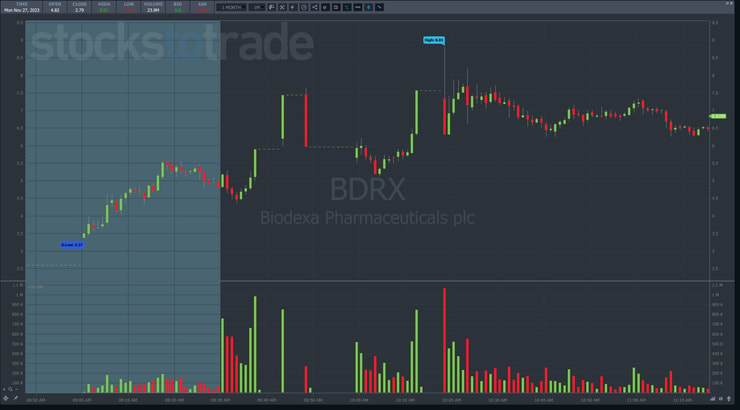Traders obsess over timing their trades to the tick, often missing them entirely.
They don’t realize it’s not about picking the perfect price but the best stock for a short squeeze.
That’s how I’ve pulled multiple winning trades out of Safety Shot (NASDAQ: SHOT)…
…And how I caught Biodexa Pharmaceuticals (NASDAQ: BDRX) right before it nearly doubled.
WOWOWOWOW $BDRX now halted at $7.44, I had my first buy at $4.73 for https://t.co/fljCJN9sHY students, I sold too soon, LOL, what a runner called by https://t.co/c1CmC1GVzk whewwwww, tell me you saw that?! SCREW SHORT SELLERS! (But thank you moron shorts too, much appreciated!)
— Timothy Sykes (@timothysykes) November 27, 2023
To the outside observer, this might seem like a fluke
But if you stick with me, I’m going to unveil how I decided BDRX was the ideal short-squeeze stock and how I traded it.
Table of Contents
Identifying the Opportunity

The single greatest investment you can make in your trading career – a quality news service.
And for my money, there’s no one better than our StocksToTrade Breaking News Chat. This team of dedicated analysts comb through the news, highlighting the stocks moving and the catalysts behind them.
Penny stocks live and die by the news that drives them. However, it’s important to understand which news is worth trading.
A bit after 9:00 a.m., our Breaking news highlighted the following headline:
Biodexa Enters Into Agreements to Acquire Exclusive Worldwide License to Tolimidone, a Phase II Ready Asset for Type 1 Diabetes.
If you’ve been following the news, you know that diabetes treatments are gaining popularity ever since Ozempic turned out to be a decent weight loss drug.
This stock also carried a small float, just shy of 700,000 shares.
Anything with less than a million shares available for active trading can be manipulated much easier by price action.
So, what I wanted to see was short sellers get trapped.
Watching the Price Action

The initial push higher was all momentum, following along my 7-Step Penny Stock Framework.
I waited for the pullback that offered me a chance to buy the stock in the uptrend but at a discount.
Was there a pullback before then? Yes. However, I was still analyzing the stock and the news catalyst.
I took the setup in the premarket, which isn’t the easiest thing to do. A similar setup would have been to buy on the pullback during the initial morning panic.
As I mentioned earlier, it’s not so much about timing the perfect entry as applying the right pattern to the framework.
This stock was on the front side of its potential parabolic move.
That makes dip buying the right choice for me.
If you want an indicator to help you, VWAP is always a popular choice.
However you choose to identify your entries, make it a methodical and repeatable process. Log the trades in your journal and you’ll find out pretty quickly what’s the best tactic for you.
Seeing the Short Squeeze
Looking at the chart below, can you see where the short squeeze occurred?
It’s right after that initial morning dip.
Notice how the volume increased as shares recovered and ran higher right into that first volatility halt.
Some traders prefer to wait to see this type of price action before jumping into the trade. That’s fine so long as you practice this method, log it, and refine it.
What you don’t want to do is end up like the short sellers, entering a trade thinking you’re getting a great risk/reward when all you’re doing is catching a falling (or, in their case, rising) knife.
I want to emphasize this point because risk management is the glue that holds everything together.
If you are letting stocks run too far instead of cutting losses quickly or chasing an entry because you don’t want to get left behind, that’s when you need to focus on executing according to your plan.
But again, it’s not about the specific prices you get. It’s about whether you make the right decisions.
Ready to Unlock the Secrets of Profitable Trading?

Trading isn’t just about perfect timing; it’s about spotting the right opportunities. Discover how to make winning trades like a pro with our live training sessions.
🔥 Dive into the world of smart trading strategies.
🔥 Learn to identify stocks with explosive potential.
🔥 Master the art of trading news catalysts.
🔥 Take control of your financial future.
Don’t be left behind—join us in our upcoming live training sessions this week. Gain the insights and skills you need to thrive in today’s dynamic market.
🚀 Get ahead of the curve and make informed decisions.
🚀 Navigate market turbulence with confidence.
🚀 Uncover hidden opportunities others miss.
🚀 Elevate your trading game to the next level.
Your path to trading success starts here. Secure your spot now!




Leave a reply